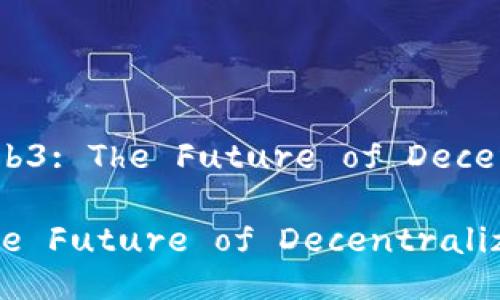Web3,即第三代互联网,被视为通过区块链技术实现去中心化的数据管理和网络交互模式的新时代。然而,这一赛道的...
In recent years, the internet has gone through several evolutionary phases, from the early days of static web pages to the interactive and dynamic landscape of Web 2.0. Now, we are entering a new transformation known as Web3. But what exactly is Web3, and why is it so pivotal for the future of the internet? In this comprehensive guide, we will delve deep into the core concepts, applications, and potential impact of Web3 technologies. This exploration will also address common questions and concerns about the decentralized internet.
Web3 represents a new paradigm in the architecture of the internet, where users have greater control over their own data, identities, and online interactions. Unlike Web 2.0, which is dominated by centralized platforms that collect and monetize user data, Web3 leverages blockchain technology to create a decentralized internet ecosystem.
The primary features that define Web3 include decentralization, user ownership, and incentivization. With the rise of blockchain technology, information can be stored across a distributed network of nodes, making it much harder for any single entity to exert control over the platform. This shift is designed to combat issues related to privacy, censorship, and monopolistic practices prevalent in today's internet.

At the heart of Web3 lies a suite of technologies that enable its decentralized nature, including:
The arrival of Web3 comes with significant implications for users:

Despite its promise, Web3 faces several challenges that must be addressed:
Web3 and Web 2.0 can be differentiated by their fundamental approaches to data ownership, control, and user interaction:
Centralization vs. Decentralization: Web 2.0 is characterized by major players like Google, Facebook, and Twitter that control user data and content moderation. In contrast, Web3 seeks to eliminate this central power structure by allowing users to interact directly and retain ownership over their data.
User Agency: In Web 2.0, users are largely passive consumers of content, while Web3 empowers users to become active participants in the online economy. Users can contribute, create, and even participate in governance through decentralized autonomous organizations (DAOs).
Economic Models: Web 2.0 primarily relies on advertising revenue models, which incentivize platforms to collect as much user data as possible. Conversely, Web3 introduces various tokenomics, including rewards and staking, that allow users to derive direct economic benefits from their participation.
Cryptocurrencies are integral to the functioning of Web3 ecosystems. They serve various purposes that facilitate decentralized operations:
Medium of Exchange: Cryptocurrencies allow users to conduct transactions without intermediaries. Whether it's for buying digital assets, accessing services, or engaging in DeFi activities, cryptocurrencies provide a seamless transfer of value.
Incentive Mechanisms: Many Web3 projects reward users for contributions, be it providing liquidity, validating transactions, or participating in governance. This incentivization helps foster community engagement and align individual interests with collective goals.
Governance: In several decentralized networks, users hold governance tokens that grant them voting rights on protocol decisions. This mechanism empowers the community to shape the future of the platform, ensuring it evolves according to users’ needs.
Yes, NFTs (Non-Fungible Tokens) are a significant element of Web3, revolutionizing the concept of ownership and authenticity in the digital realm:
Unique Ownership: Unlike cryptocurrencies, which are fungible and can be exchanged one-for-one, NFTs represent unique digital items. This uniqueness allows for the verification of ownership and provenance, which is crucial for digital art, music, and collectibles.
Empowering Creators: NFTs enable artists and creators to tokenize their work, establishing a direct connection with their audience. This eliminates the need for intermediaries, allowing creators to retain a higher percentage of their earnings.
Utility and Engagement: Beyond mere ownership, NFTs are used in various applications including gaming, virtual worlds, and membership access. They grant users special privileges, fostering engagement in ways traditional assets cannot.
Decentralized Autonomous Organizations (DAOs) are a key innovation in Web3, representing a new model of organization and governance:
Community Governance: DAOs operate on blockchain technology, allowing members to propose and vote on decisions collectively. This democratic approach ensures that all voices are heard and that governance is transparent.
Flexible Structures: DAOs can be formed for various purposes, including funding proposals, community initiatives, or even managing investment funds. Members can collaborate without a traditional hierarchical structure, leading to increased agility and responsiveness.
Funding and Incentives: Many DAOs utilize tokens for governance and funding initiatives. Token holders may be incentivized to engage actively in decision-making processes, aligning financial interests with organizational goals.
While Web3 presents a vision of a decentralized internet that could potentially replace many traditional systems, the timeline for such a transformation is complex and uncertain:
Incremental Adoption: Realistically, the transition from centralized systems to Web3 will occur gradually rather than abruptly. As users become more aware of the benefits of decentralization, they may shift to Web3 solutions alongside existing technologies.
Integration with Traditional Systems: In many cases, Web3 could coexist with traditional systems, enhancing them rather than completely replacing them. For instance, hybrid models could emerge, utilizing blockchain to bring transparency and efficiency to existing frameworks.
Future Vision: The ultimate realization of the full potential of Web3 depends on several factors, including technological advancements, regulatory clarity, and user adoption rates. Social, cultural, and economic drivers will also play a considerable role in shaping the future of the internet.
In conclusion, Web3 represents a groundbreaking shift in how we interact with the internet, emphasizing decentralization, user ownership, and economic empowerment. While challenges remain, the potential benefits of a Web3-enabled future are immense, promising a more equitable digital landscape for all users.